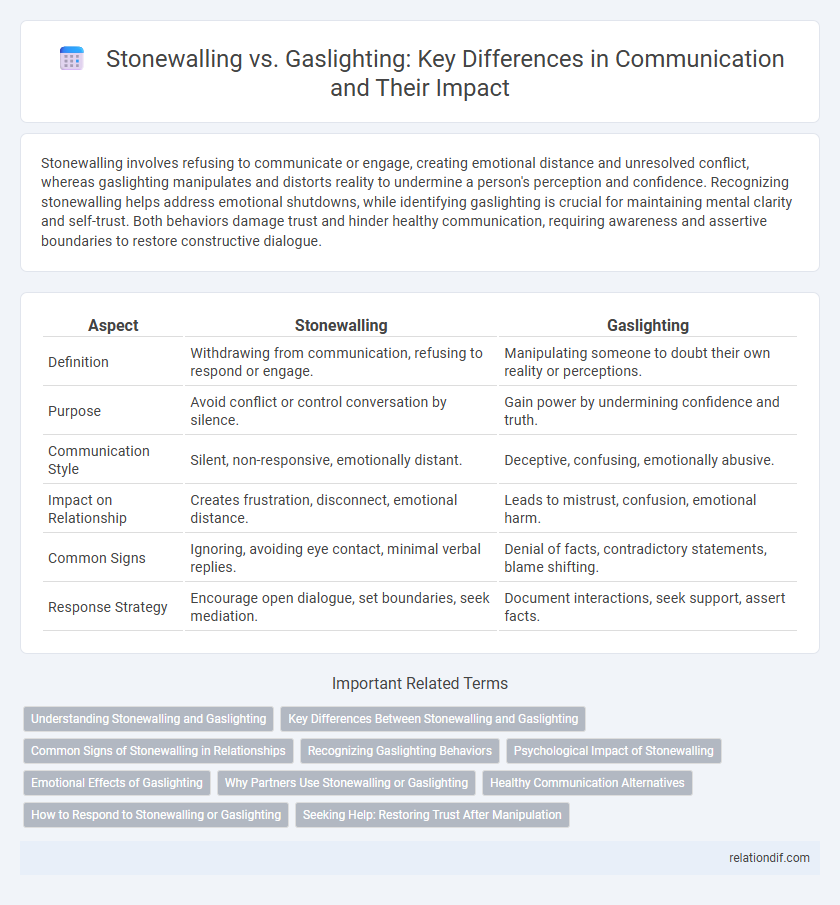Stonewalling involves refusing to communicate or engage, creating emotional distance and unresolved conflict, whereas gaslighting manipulates and distorts reality to undermine a person's perception and confidence. Recognizing stonewalling helps address emotional shutdowns, while identifying gaslighting is crucial for maintaining mental clarity and self-trust. Both behaviors damage trust and hinder healthy communication, requiring awareness and assertive boundaries to restore constructive dialogue.
Table of Comparison
| Aspect | Stonewalling | Gaslighting |
|---|---|---|
| Definition | Withdrawing from communication, refusing to respond or engage. | Manipulating someone to doubt their own reality or perceptions. |
| Purpose | Avoid conflict or control conversation by silence. | Gain power by undermining confidence and truth. |
| Communication Style | Silent, non-responsive, emotionally distant. | Deceptive, confusing, emotionally abusive. |
| Impact on Relationship | Creates frustration, disconnect, emotional distance. | Leads to mistrust, confusion, emotional harm. |
| Common Signs | Ignoring, avoiding eye contact, minimal verbal replies. | Denial of facts, contradictory statements, blame shifting. |
| Response Strategy | Encourage open dialogue, set boundaries, seek mediation. | Document interactions, seek support, assert facts. |
Understanding Stonewalling and Gaslighting
Stonewalling involves refusing to engage or communicate, creating emotional distance and frustration in conversations, while gaslighting manipulates facts to make someone question their reality and sanity. Recognizing stonewalling requires spotting patterns of avoidance and silence that block conflict resolution. Identifying gaslighting depends on detecting persistent distortion of truth aimed at undermining someone's confidence and perception.
Key Differences Between Stonewalling and Gaslighting
Stonewalling involves emotionally shutting down and refusing to engage in communication, creating a barrier to resolving conflicts. Gaslighting manipulates another person's perception of reality, causing self-doubt and confusion to control or undermine them. The key difference lies in stonewalling's withdrawal from interaction versus gaslighting's active distortion of truth to manipulate.
Common Signs of Stonewalling in Relationships
Common signs of stonewalling in relationships include emotional withdrawal, where one partner shuts down and refuses to engage in conversations, creating a barrier to communication. This behavior often manifests as silence, avoiding eye contact, or physically leaving the room during conflicts. Persistent stonewalling leads to frustration, unresolved issues, and emotional distance, severely impacting relationship trust and intimacy.
Recognizing Gaslighting Behaviors
Gaslighting behaviors include denying facts, twisting information, and manipulating memories to make the victim question their reality. Recognizing repeated instances of trivializing feelings or dismissing concerns as irrational signals emotional abuse. Identifying these patterns early is crucial for maintaining mental health and fostering transparent communication.
Psychological Impact of Stonewalling
Stonewalling in communication triggers significant psychological distress, often leading to feelings of frustration, helplessness, and emotional isolation. This behavior impedes conflict resolution by shutting down dialogue, which can exacerbate anxiety and depression in individuals subjected to persistent emotional withdrawal. Prolonged exposure to stonewalling may also erode trust and damage the overall mental well-being of affected parties.
Emotional Effects of Gaslighting
Gaslighting causes profound emotional distress by eroding an individual's sense of reality, leading to confusion, anxiety, and diminished self-esteem. Victims often experience chronic self-doubt, helplessness, and feelings of isolation as their perceptions and memories are persistently questioned or denied. This psychological manipulation severely impacts mental health, increasing risks of depression, trauma, and long-term emotional instability.
Why Partners Use Stonewalling or Gaslighting
Partners often use stonewalling to avoid conflict or to gain control by shutting down communication and creating emotional distance. Gaslighting is employed to manipulate perception, causing the victim to doubt their reality and maintain dominance in the relationship. Both tactics stem from fear of vulnerability, insecurity, or a desire to exert power over the partner.
Healthy Communication Alternatives
Healthy communication alternatives to stonewalling and gaslighting include active listening, where individuals genuinely hear and validate each other's feelings, fostering trust and understanding. Employing clear, honest expression of thoughts paired with empathy reduces misunderstandings and emotional manipulation, promoting mutual respect. Conflict resolution techniques, such as using "I" statements and seeking collaborative solutions, strengthen relationships by encouraging openness and accountability.
How to Respond to Stonewalling or Gaslighting
Responding to stonewalling requires setting clear boundaries and calmly requesting open communication, while avoiding escalation and seeking professional mediation if necessary. When confronting gaslighting, document conversations to preserve facts and assert your perceptions firmly, reinforcing your reality to counter manipulation. Prioritizing emotional safety and seeking support from trusted sources can help effectively address both behaviors in communication.
Seeking Help: Restoring Trust After Manipulation
Seeking help after experiencing stonewalling or gaslighting involves engaging with professional therapists specializing in emotional abuse recovery to rebuild trust and establish healthy communication patterns. Structured therapy sessions, including cognitive-behavioral therapy (CBT) or trauma-informed counseling, provide tools to recognize manipulation, set boundaries, and restore self-esteem. Support groups and trusted social networks offer a crucial environment for validation and empowerment, accelerating the healing process and fostering resilience in interpersonal relationships.
Stonewalling vs Gaslighting Infographic

 relationdif.com
relationdif.com